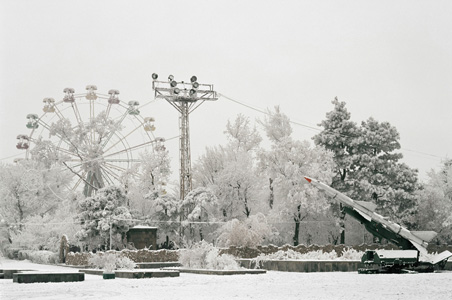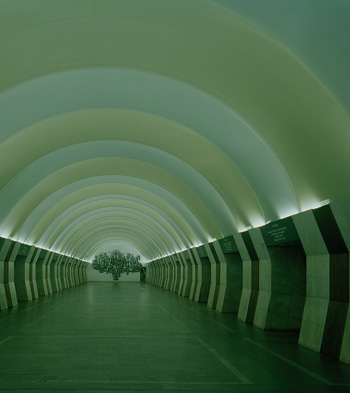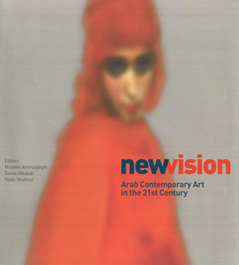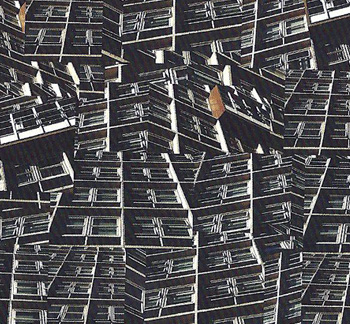Sønke Gau
(Originally printed in Camera Austria)
 Unfinished (2007) and InBetween (2006) are the titles of the two series of works by photo-artist Hrair Sarkissian, born in Damascus in 1973, that we will discuss in this text. Both titles describe phases of transition, an ‘in-between’ in terms of both space and time. The photos of building shells in various Middle East cities (Unfinished) and the views of snowy landscapes, buildings and monuments in Armenia (InBetween) depict various transitory stages on the level of representation. In addition, the staging of the visible, the lavish, almost theatrical illumination of the rooms and the elegiac-style sepia effect refer to a real or imaginary past or future. Hrair Sarkissian’s works revolve around individual and ‘collective’ memory and identity.
Unfinished (2007) and InBetween (2006) are the titles of the two series of works by photo-artist Hrair Sarkissian, born in Damascus in 1973, that we will discuss in this text. Both titles describe phases of transition, an ‘in-between’ in terms of both space and time. The photos of building shells in various Middle East cities (Unfinished) and the views of snowy landscapes, buildings and monuments in Armenia (InBetween) depict various transitory stages on the level of representation. In addition, the staging of the visible, the lavish, almost theatrical illumination of the rooms and the elegiac-style sepia effect refer to a real or imaginary past or future. Hrair Sarkissian’s works revolve around individual and ‘collective’ memory and identity.
Architecture that, on the one hand, shapes everyday social life and, on the other, visualises society and ideology, acts in this context as a medium of observation. Maurice Halbwachs already pointed out how architectural phenomena evoke a ‘collective memory’ – but the meanings are not easy to read, but must rather be created by way of discourse and may be overwritten and redefined. According to Ernesto Laclau’s theories on hegemony and democracy, practices of spatialisation work on a ‘hegemonisation of time’ and thus on a cementation of meaning. Because the ‘dislocational’ effects of time, to which every structure is subject, can never be completely eliminated, it is necessary to articulate the codification and perpetuation of meaning on an ongoing basis. This is achieved by means of a practice of repetitions, manifested, for example, in national, religious or historical myths of memory. The past is articulated on the level of hegemonic representation as a ‘dominant fiction’ (following Kaja Silverman), that attempts to suppress heterogeneous allocations of meaning by means of homogenisation. A selection of specific points of reference in the past is intended to create a we-identity in their “spatialisation”. This was and is often achieved by means of a process that we might, going back to Nietzsche, refer to as ‘monumentalistic historiography’ – i.e. the selected points of reference are intended to construct a heroic self-image of a group that is often exaggerated in myths with the aid of demonisations. An expression of a ‘monumentalistic historiography’ may, for example, be national holidays or, in the literal sense, ‘monuments’, that, on the one hand, also constitute a ‘spatialisation’ in the sense of Laclau, but, in addition, also manifest themselves palpably in physical space.
Hrair Sarkissian’s InBetween series presents photos of socialist architectures and memorials in the context of the military conflict between Armenia and Azerbaijan. The weapons intended to remind us of the conflict for the Nagorno-Karaback region, from which Armenia emerged victorious, are symbolically aimed at Turkey, in which most of Armenia’s historical settlement area is today located. The heroic memorials are a visible expression of ‘spatialisation’, that proclaim a ‘collective identity’ through monuments. With his photos, Sarkissian, who was born in Syria, but whose family comes from Armenia, spotlights the discrepancy between the image of a proud nation that state-run educational institutions draft of the Armenian Diaspora for the rest of the world and reality in the country itself. He contrasts the concrete representations of state-proclaimed identity with views of barren landscapes and slums. The deserted hotel complexes date back  to the time when Armenia was a Soviet Union republic and a popular holiday destination in the Soviet Union thanks to its warm climate. After the declaration of independence in 1991, holiday-makers stopped coming and new investors were not to be found. The partially incomplete building shells are already falling into disrepair but because it is too expensive to demolish them, they remain as ‘unwanted’ monuments to the fact that the country was not able to realise its objectives of economic upturn and prosperity. Laclau refers to the fact that every system is pervaded with constitutive ambivalences preventing complete totalisation as “dislocation”. Unlike ‘spatialisation’, dislocational effects are a temporal phenomenon. The temporalisation of space leads to a defixation of codified meanings. The fog and snow and the brownish coloration of Sarkissian’s photographs emphasise the aspect of temporality in a non-stabilised hypothetical construct of ‘collective identity’ intended to generate a certain we-consciousness but that is obviously full of cracks.
to the time when Armenia was a Soviet Union republic and a popular holiday destination in the Soviet Union thanks to its warm climate. After the declaration of independence in 1991, holiday-makers stopped coming and new investors were not to be found. The partially incomplete building shells are already falling into disrepair but because it is too expensive to demolish them, they remain as ‘unwanted’ monuments to the fact that the country was not able to realise its objectives of economic upturn and prosperity. Laclau refers to the fact that every system is pervaded with constitutive ambivalences preventing complete totalisation as “dislocation”. Unlike ‘spatialisation’, dislocational effects are a temporal phenomenon. The temporalisation of space leads to a defixation of codified meanings. The fog and snow and the brownish coloration of Sarkissian’s photographs emphasise the aspect of temporality in a non-stabilised hypothetical construct of ‘collective identity’ intended to generate a certain we-consciousness but that is obviously full of cracks.
With reference to the importance of ‘memory as a legitimisation resource’, Aleida Assmann writes that the history taught in textbooks and commemorated on anniversaries is something like the collective biography of a nation, but that – just like the individual biography – is recounted differently particularly after crises or political turning-points. “The history that is remembered consolidates the self-image of an individual and of a group. Hence, what we remember is determined not by what actually happened, but rather by what we can and want to tell a story about later. What we do and do not remember from the past ultimately depends on who uses the history and for what purpose. Aleida Assmann in Erinnerung und Geschichte states that Hrair Sarkissian tries to illustrate this by contrasting different narrations. The ‘stereoscopic’ effect that this causes spotlights the constructed nature of history and identity. The resulting image is an imaginary one but illustrates the powerfully effective ideologies underlying the staging of the visible layer. The theatrical aspect of his photographs highlights the significance of images in constructions of history and identity, as our relationship with the past is determined and regulated to a substantial degree by, through and in the image medium.
Sarkissian also pursues his interest in the ‘invisible in the visible’ in his Unfinished series. The photographs, taken in various cities of the Middle East, show details of buildings still under construction and not accessible to the public. With reference to popular historical photographs of architecture from the region, that often feature picturesque ruins, archaeological finds or other places with ‘history’ and that, for the artist, are to be seen in the context of the stereotyping of the ‘Orient’ by European artists, writers and scientists, he presents places that are still ‘under construction’ and forward-looking. The focus is on considerations as to whether architecture or the representation of architecture can tell us something about the ‘architecture of society’ both in terms of ascription by others and self-perception. Architecture is, on the one hand, a mirror, expression and testimony of a society and, on the other, a medium of the social and hence socially constitutive. As an apparatus of perception, architecture is also a ‘theatre’ of representations. Places are increasingly staged and received through images, the perception of places is increasingly structured by the media. In their outward representation, façades act as a masquerade that promises something hidden behind them, it is an ‘architecture of promising’, a material manifestation of desire. The buildings that Sarkissian photographs from the inside are in a stage before their ‘appearance’ as images in public perception and representation. They are insights into the building sites behind the façades that, by dint of their set-like staging, emphasise the performative nature of architecture that is always equally an expression of an economy of desire. At the interface between projections from the outside and inside, in the sense of Lacan, they also spotlight the fact that a completed identity cannot be achieved as desire is defined by reality, that always appears only as imperfection. But at the same time, the ‘unfinished’, ‘in-between’ aspect also offers the possibility of de-fixing meaning in the sense of a productive renegotiation, a temporalisation of space.
Sønke Gau
Hrair Sarkissian was featured in the New Ends, Old Beginnings exhibition.

 While taking notes to write the present review, I was confronted with a set of questions very similar to the ones that the recently published New Vision: Arab Contemporary Art in the 21st Century, sought to tackle. In their most general sense, these questions are about the problem of history, or rather, the ways of writing histories.
While taking notes to write the present review, I was confronted with a set of questions very similar to the ones that the recently published New Vision: Arab Contemporary Art in the 21st Century, sought to tackle. In their most general sense, these questions are about the problem of history, or rather, the ways of writing histories.




